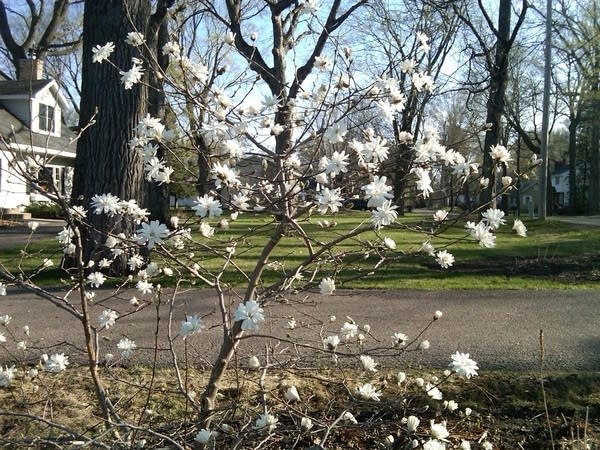Spring Outlook: Weather conditions favor first ‘real spring’ in 3 years?

Searching for Spring
Springtime in Minnesota can be a fleeting mirage.
It seems like one day a winter's worth of snow melts away. The next day warm, humid summer-like breezes blow in from the south and Minnesotans complain it's too hot and humid.
If we're lucky, there's that one day in April when warm sunshine boosts temperatures to 70 degrees. Fresh light breezes and pristine blue skies make it feel like all is well with the world. Daffodils and tulips bloom. Birds sing. The ice goes out on your local lake. You see long-lost neighbors strolling by with smiles on their faces. A wave of uncontrollable optimism spreads like mosquitoes in early June. The Twins will make the playoffs. The Vikings could actually win the Super Bowl.
Create a More Connected Minnesota
MPR News is your trusted resource for the news you need. With your support, MPR News brings accessible, courageous journalism and authentic conversation to everyone - free of paywalls and barriers. Your gift makes a difference.
That's when you know it's finally springtime in Minnesota.

The past two "springs" in Minnesota have been especially extreme. In fact it's been three years since Minnesotans have enjoyed anything close to what can be considered a normal spring.
Here's a closer look with data from the Minnesota Climatology Working Group.
Spring 2012: Warmest spring on record in the Twin Cities and all of central and southern Minnesota.
Spring 2012 is the warmest Spring on record over central and southern Minnesota and is in the top five warmest over northern Minnesota.
Meteorological Spring (March-May) will finish with an estimate of 54.0 degrees at the Twin Cities International Airport. This will make 2012 the warmest spring on record since modern record keeping began in 1873. The old record was 52.5 degrees in 1977. In addition, 2012 is the warmest Spring on record for other locations across central and southern Minnesota, including St. Cloud and Rochester. Farther to the north, Duluth tied the warmest spring on record and International Falls had the 4th warmest spring.
The warm spring was helped out enormously by the warmest March recorded in Minnesota's history. The average temperature in the Twin Cities was 48.3 degrees, 15.5 degrees above normal. April followed with 50.0 degrees, 2.5 degrees above normal and May 2012 (though May 30) had 63.9 degrees, 4.9 degrees above normal.
It was also a wet spring as well. The total precipitation in the Twin Cities from March to May 2012 was 13.78 inches, 5.87 inches above normal. This was enough to finish in second place for the wettest meteorological Spring back to 1871. The wettest Spring on record is 1965 with 16.13 inches of precipitation.
Top Three Average Spring (March-May) Average Temperatures for Select Locations
(All are in Degrees F)
Twin Cities (1981-2010 Normal: 46.6 degrees)
Rank Ave Temp Year
------------------
1. 54.0 2012
2. 52.5 1977
3. 52.2 2010
Fast forward to spring 2013: Cool, wet and snowy. Some of the latest ice-out dates on record for Minnesota lakes. Snowiest month ever recorded at Duluth with over 50 inches.
The 2013 meteorological spring season exhibited cooler than normal temperatures and plenty of precipitation for Minnesota and surrounding regions. For many regions the precipitation ranked in the top 15 years of data keeping for spring, however most locations were eclipsed by the 2012 spring season. This being said, the 2013 spring season still had some of the highest amounts of precipitation on record. A couple of interesting notes-- Rochester had the wettest spring on record, beating out 2001’s precipitation by over 6 inches. Fargo also had a wet spring, yet it could not beat out 1902’s record at 11.44 inches.
Spring (Mar. 1st -- May 31st) 2013 Precipitation in Inches (High --> Low)
Location Rank Precip. Dep. From Normal
------------------------------------------------
Twin Cities 4th 13.50 +6.19
St Cloud 13th 10.51 +3.45
Duluth 14th 10.79 +3.71
Fargo 2nd 10.71 +5.27
Grand Forks 11th 7.38 +3.11
Sioux Falls 15th 10.96 +4.28
Rochester 1st 21.90 +13.62
La Crosse 2nd 16.53 +8.17
Intl. Falls 7th 8.72 +4.41
Spring 2011 was the last year the season resembled anything close to a normal "spring"in Minnesota. Temperatures at Minneapolis-St. Paul International Airport ran very close to average in spring 2011, at just 0.2F below the long-term averages, according to Minnesota Climatology Working Group data.

The data clear shows some extreme "spring whiplash" the last two years in Minnesota.
Spring 2014: Closer to a 'normal' spring?
Looking at the maps today I am struck that conditions seem favorable for a more normal spring in Minnesota this year.
We have several factors working towards what could be a far less extreme spring in 2014 than the past two years. I can't make any concrete predictions about Spring 2014 in the Upper Midwest, but I do seem some potential emerging trends.
Abundant snow cover now across Minnesota should temper any sharp temperature rises.
Gradual northward trend in jet stream the next one two weeks should offer gradual warming trend.
Gradual snow melt could keep temperatures much closer to average than the past two springs in Minnesota.
Gradual snow melt could help ease flood potential, but that could change on a moment's notice with a rapid warm up and/or severe spring rainstorm.
Here's a look at temps going out 16 days according to the National Oceanic and Atmospheric Administration's Global Forecast System model. You can see the gradual warming trend. If this outlook verifies, many days above freezing, and nights below freezing could mean a gradual snow melt starting in earnest next week.

One thing for sure. Minnesota weather can change in an instant. Things may look favorable for a more normal spring this year as of today, but that could change in a heartbeat. One wild card will be how many, if any March snow storms we see in the next three weeks.
Stay tuned!